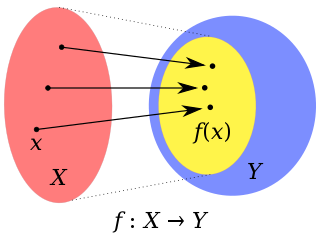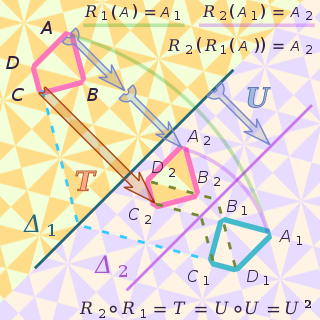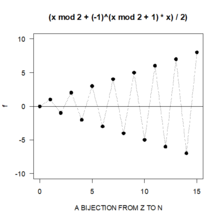In mathematics, a binary relation associates elements of one set, called the domain, with elements of another set, called the codomain. A binary relation over sets X and Y is a set of ordered pairs (x, y) consisting of elements x from X and y from Y. It is a generalization of the more widely understood idea of a unary function. It encodes the common concept of relation: an element x is related to an element y, if and only if the pair (x, y) belongs to the set of ordered pairs that defines the binary relation. A binary relation is the most studied special case n = 2 of an n-ary relation over sets X1, ..., Xn, which is a subset of the Cartesian product
In mathematics, a set is countable if either it is finite or it can be made in one to one correspondence with the set of natural numbers. Equivalently, a set is countable if there exists an injective function from it into the natural numbers; this means that each element in the set may be associated to a unique natural number, or that the elements of the set can be counted one at a time, although the counting may never finish due to an infinite number of elements.

In mathematics, an equivalence relation is a binary relation that is reflexive, symmetric and transitive. The equipollence relation between line segments in geometry is a common example of an equivalence relation. A simpler example is equality. Any number is equal to itself (reflexive). If , then (symmetric). If and , then (transitive).
In algebra, a homomorphism is a structure-preserving map between two algebraic structures of the same type. The word homomorphism comes from the Ancient Greek language: ὁμός meaning "same" and μορφή meaning "form" or "shape". However, the word was apparently introduced to mathematics due to a (mis)translation of German ähnlich meaning "similar" to ὁμός meaning "same". The term "homomorphism" appeared as early as 1892, when it was attributed to the German mathematician Felix Klein (1849–1925).

In mathematics, the inverse function of a function f is a function that undoes the operation of f. The inverse of f exists if and only if f is bijective, and if it exists, is denoted by
In mathematics, a partial functionf from a set X to a set Y is a function from a subset S of X to Y. The subset S, that is, the domain of f viewed as a function, is called the domain of definition or natural domain of f. If S equals X, that is, if f is defined on every element in X, then f is said to be a total function.
In mathematics, a surjective function (also known as surjection, or onto function ) is a function f such that, for every element y of the function's codomain, there exists at least one element x in the function's domain such that f(x) = y. In other words, for a function f : X → Y, the codomain Y is the image of the function's domain X. It is not required that x be unique; the function f may map one or more elements of X to the same element of Y.
In mathematics, an injective function (also known as injection, or one-to-one function ) is a function f that maps distinct elements of its domain to distinct elements; that is, x1 ≠ x2 implies f(x1) ≠ f(x2). (Equivalently, f(x1) = f(x2) implies x1 = x2 in the equivalent contrapositive statement.) In other words, every element of the function's codomain is the image of at most one element of its domain. The term one-to-one function must not be confused with one-to-one correspondence that refers to bijective functions, which are functions such that each element in the codomain is an image of exactly one element in the domain.
In mathematics, the concept of an inverse element generalises the concepts of opposite and reciprocal of numbers.

In mathematics, the domain of a function is the set of inputs accepted by the function. It is sometimes denoted by or , where f is the function. In layman's terms, the domain of a function can generally be thought of as "what x can be".

In mathematics, a codomain or set of destination of a function is a set into which all of the output of the function is constrained to fall. It is the set Y in the notation f: X → Y. The term range is sometimes ambiguously used to refer to either the codomain or the image of a function.
In category theory, an epimorphism is a morphism f : X → Y that is right-cancellative in the sense that, for all objects Z and all morphisms g1, g2: Y → Z,
In mathematics, a function from a set X to a set Y assigns to each element of X exactly one element of Y. The set X is called the domain of the function and the set Y is called the codomain of the function.

In mathematics, an isometry is a distance-preserving transformation between metric spaces, usually assumed to be bijective. The word isometry is derived from the Ancient Greek: ἴσος isos meaning "equal", and μέτρον metron meaning "measure". If the transformation is from a metric space to itself, it is a kind of geometric transformation known as a motion.

In mathematics, the range of a function may refer to either of two closely related concepts:
In mathematics, more specifically in topology, an open map is a function between two topological spaces that maps open sets to open sets. That is, a function is open if for any open set in the image is open in Likewise, a closed map is a function that maps closed sets to closed sets. A map may be open, closed, both, or neither; in particular, an open map need not be closed and vice versa.

In mathematics, a map or mapping is a function in its general sense. These terms may have originated as from the process of making a geographical map: mapping the Earth surface to a sheet of paper.

In mathematics, injections, surjections, and bijections are classes of functions distinguished by the manner in which arguments and images are related or mapped to each other.
In mathematics, particularly in category theory, a morphism is a structure-preserving map from one mathematical structure to another one of the same type. The notion of morphism recurs in much of contemporary mathematics. In set theory, morphisms are functions; in linear algebra, linear transformations; in group theory, group homomorphisms; in analysis and topology, continuous functions, and so on.
This topic is a basic concept in set theory and can be found in any text which includes an introduction to set theory. Almost all texts that deal with an introduction to writing proofs will include a section on set theory, so the topic may be found in any of these:
































